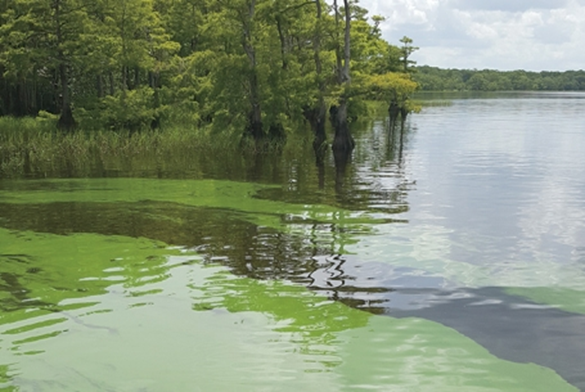So-called “biosolids” can worsen toxic algae in Florida’s waters; they also may carry PFAS into waterways.
By Valerie Izquierdo

The St. Johns River flows with both wonder and pollution for its 310 miles from the Indian River to Jacksonville.
Florida’s largest river is beloved for its varied wildlife and popular activities like fishing and canoeing. But it can also be unhealthy. River advocates say pollution increasingly includes sewage sludge reaching its waters from nearby agricultural areas where the sludge has been spread as fertilizer.
Sewage sludge, in a few words, is concentrated human waste. It is a by-product of wastewater treatment. As Florida’s population grows by an average 1,000 people each day, so does the volume of sewage. The state Department of Environmental Protection allows treated sludge, known euphemistically as biosolids, to be spread as fertilizer with a permit. The Legislature in 2007 prohibited such use of sewage sludge in southeast Florida to protect watersheds connected to waterways such as the Kissimmee, Okeechobee and the Everglades.
That policy “has left everybody else vulnerable,” said Lisa Rinaman of the St. Johns Riverkeeper, an advocacy and awareness organization. Sewage sludge spread on farmlands adjacent to waters including the St. Johns leaks into the river when it rains. It runs into the river and down into groundwater. And it takes decades to undo the pollution, Rinaman says. River advocates worry that the forever chemicals known as PFAS are part of that pollution.
Wetlands and other vegetation surrounding the St. Johns help protect the river; they are the kidneys that filter pollution and help keep the water clean. But like kidneys, they can only take so much. Sewage sludge has contributed to phosphorous pollution in the headwaters of the St. Johns, a common cause of algae blooms, according to the 2020 River Report, an annual report prepared for the city of Jacksonville by a team of universities. The team is reviewing the threat of PFAS for its 2021 River Report.
Land application is the No. 1 way sewage sludge is disposed of nationally. According to the EPA, about 60% of biosolids are applied to agricultural lands. The agency reports that PFAS in biosolids is a concern, but further studies are needed to learn whether the forever chemicals can make their way into crops fertilized with the sludge.
» SEE ALSO: Do Forever Chemicals Make Their Way into Food?
Florida is home to about 140 permitted land-spreading sites for biosolids, which are spread around the state except in the southeast and at the southern tip due to the greater protections in those areas.
At least one local government, Indian River County, has already declared a moratorium on minimally treated biosolids over concerns about their impact on Blue Cypress Lake, the headwaters lake of the St. Johns. During last year’s legislative session, lawmakers passed and Gov. Ron DeSantis signed into law the Clean Waterways Act sponsored by Senator Debbie Mayfield, a Brevard County Republican. The new law deals with what are considered the most serious sources of pollution causing blue-green algae in waterways, including new rules for spreading biosolids on Florida lands.
The new rules fall short of the moratorium river advocates have lobbied for, especially given that much of the sewage sludge threatening the St. Johns comes from southeast Florida — where the waterways are protected from it. That’s “a major insult,” Rinaman said.
 Forever in Florida
Forever in Florida